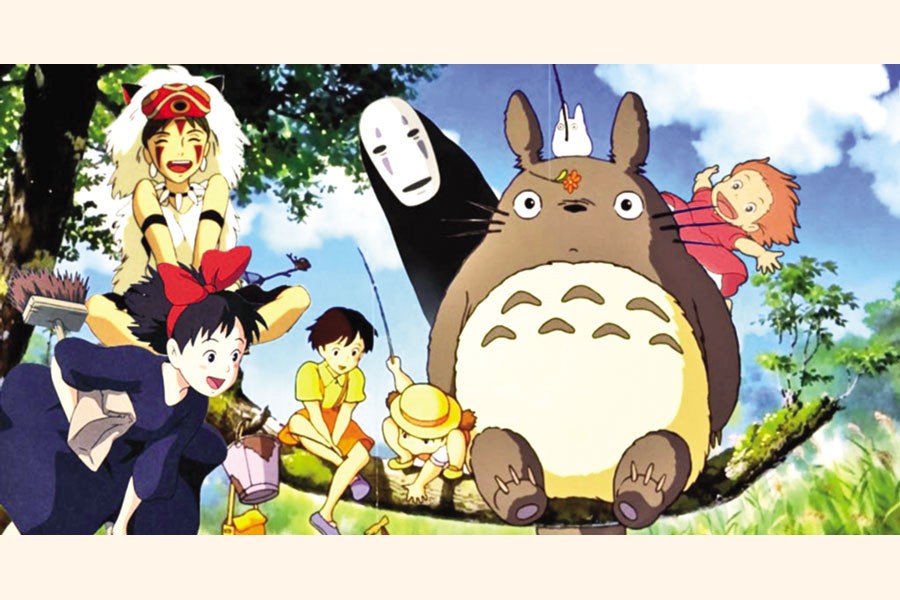Who would have thought the fantasy of many students attending lectures under a warm blanket would come true? For the majority part of the last year, many spent their time coping with watching the cheerful faces of classmates limited to Zoom rectangles while refreshing the Google Covid-19 tracker, as true normalcy seemed in distant vision.
But trying to be normal like the pandemic never happened, taking the time to relish morning tea even though it comes from a packet of tea bags instead of the warmth of 'Adda' sessions in a Dhakai 'Tong,' and devoting a few minutes to appreciate the changing colour palettes of sunsets, listening to the rhythmic cooing noise of the pigeons who had made themselves at home on the ledge-- one can try all these to feel normal, or watch a Studio Ghibli film. In this time of pandemic and all the mental stress, it can be a way to keep the mind fresh.
There are a lot of elements in Hayao Miyazaki (cofounder of Studio Ghibli) and his works to be praised-- the meticulously hand-drawing animation, amazing plots, the teenage heroines, who-- decades before Disney's Elsa, sang 'Let it Go'-- were willing to go free-spirited, etc. In Japanese, it's called 'Ma'- the silent, omnipresent times, the idea of a negative room. This concept gives Studio Ghibli films their trademark sense of immersive reality, whether in spectacular fantasies like 'Princess Mononoke' or films like 'My Neighbour Totoro' that curled along without a broad conflict.
One such example is the moment when Kiki arrived in the city after causing a ruckus and running away from the cops in 'Kiki's Delivery Service.' She stood silently by the cobblestone fence on the hill, staring down at the city. Without a single word, we sense Kiki's doubts on staying in that city, as well as her uncertainty and fear of being rejected.
Another example is in Ponyo, an adaptation of Hans Christian Andersen's 'The Little Mermaid.' Lisa prepares instant noodles and honey tea with ham for her son Sosuke and his newly made human friend Ponyo after a perilous drive along the edge of a scary Tsunami. The scene is sublime with the abundance of steam coming from the ramen bowls and the sparkling honey stuck to a spoon as it is swirled around in a mug gives warm and shimmering beauty to the entire thing. But it is the joy of kids' childlike pleasure-- Sosuke's delight at showing her how to eat and drink and Ponyo's obsession with 'haaam'-- that makes it so unforgettable.
Kami (spirit) visitors bathe, feast and socialise in abundance at Spirited Away's mystical bathhouse. However, both human and non-human bathhouse workers go through their days in the same way as the working class of every other small little town in reality does. They waste hours at their tedious occupations, washing, waitressing, and feeding the furnace; during their leisure time, they enjoy basic meals and aspire to relocate to the big city one day. These scenes do little to advance the storyline of the film, breaking many 'rules' of the Western narrative. Without them, the realm of the spirits would be far shallower, and the ubiquitous sense that this world was not so foreign to us would be destroyed.
The majority of the Miyazaki films are focused and aimed at children. However, this works as an advantage, not a weakness. According to Miyazaki, what makes children the ideal tool for exploring his universes is that they have not had their childhood abused by adult common sense.
In 'My Neighbour Totoro,'the Kusakabe sisters, Satsuki and Mei, welcome every aspect of their new village home, from the aged, rusty cottage to the diverse Kami that roam the countryside. While waiting at a bus stop amid a downpour, Totoro gladly accepts an umbrella offered by Satsuki. He finds the plip-plop of huge drops of water from tree leaves dancing onto his umbrella so enthralling that he leaps in joy and causes all the waters from the leaves to rain. He gifts the sisters a pouch of 'Jack and the Beanstalk'-esque enchanted seeds and leaves hastily in a yowling bus-shaped cat with headlights for eyes after loving the consequences of his mischief.
It is the sisters' fierce freedom, coupled with a youthful sense of wonder and trust that encourages them, and thus the audience, to see Totoro as something like a giant, snuggly teddy bear and a protector-god, to dive into his mysterious world with just the slightest puzzlement. At its core, it is a straightforward tale about two girls exploring an imagined monster while coping with the emotional burden of a sick mother and relocation. Miyazaki and Ghibli do not see fantasy as just escapism. They consider it to be something fundamental to human existence.
One can also watch Kiki's Delivery Service for its remarkably mature portrayal of artistic burnout and solitude or just her adorable cat, Castle in the sky for its powerful perspectives on capitalism and technology, or its wonderful portrait of the very ordinary family life of some exceptional airborne pirates. But either way, Studio Ghibli's ability to add magical colours to the mundane will enable one to view the world around in a new light, even if that world is confined to the living room during a pandemic.
The writer is a student of International Relations at Bangladesh University of Professionals. [email protected]


